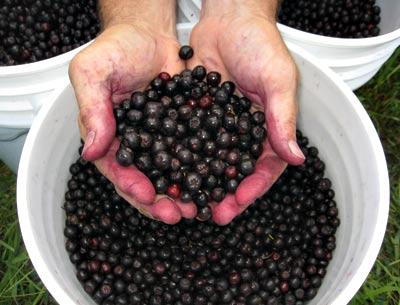Aronia Berries for Amagansett?

Details of one proposal submitted to East Hampton Town for use of the 19-acre Amagansett Farm, purchased by the town this year to prevent its development as luxury over-50 housing, were provided this week by Henry C. Blazer, a Missouri and 25-year East Hampton resident.
Mr. Blazer, known as Chip, and a partner, Seymour Ross of East Hampton, would like to grow aronia berries, described as an up-and-coming new “super food.”
Their project is one of six being considered by the town. The competing proposals, which will be vetted by the town’s community preservation fund committee before a recommendation is made to the town board, include two from local farmers — Good Water Farms and the Bunker Hill Corner Farm Collaborative — one from a Montauk horse breeder, one from the South Fork Country Club together with Balsam Farm of Amagansett, and the sixth from George Stankevich, an East Hampton attorney. Mr. Stankevich submitted a letter on behalf of “several ultra-high-net-worth individuals, Fortune 500 companies, and local founding families” interested in using the property; the letter did not say how. The Star reported last week on details of the various proposals.
Mr. Blazer and his brother, Steve Blazer, operate Blazer Farmz in the Missouri Valley, where they have grown and distributed aronia berries for over five years, along with elderberry, black currants, paw paw, chestnuts, and other crops.
The bushes, which are native to North America and indigenous on the East End, bear a purple fruit the size of a blueberry that has been lauded for its high antioxidant content. The berries, with a taste similar to wine grapes, can be eaten fresh, Chip Blazer said this week, or pressed for juice. They are also used as ingredients in many other products, from baked goods to jams, tea, salsa, and ice cream, to cosmetics, and are added to wine grapes to enhance taste, he said.
Commonly called chokeberry, the perennial, deciduous plants grow wild in Montauk and are often installed as a landscape plant; there are bushes around some East Hampton Town buildings, and they are included on a town-approved list of native plants. They have dark green leaves that turn red in the fall, and creamy white flowers in spring. The purple-black berries ripen in August.
According to Blazer Farmz’s proposal, “the aronia berry will only add to the biodiversity of our local produce and not be competitive. The new fruit should stimulate new business relationships in the food, health, beverage, and the wine industries.”
The berries would be raised organically on a 10-acre section of the land, with 56 rows of bushes between “wide lanes of grass,” creating, the proposal says, “a unique picturesque landscape similar to [a] grape vineyard, minus the trellises.”
The aronia farmers would create a reception and information area on the main floor of an existing barn. They said they would seek certification to use the kitchen for small-batch juicing and berry processing, and would share or lease it to other food producers as well.
A seasonal farm stand outside the barn would offer not only berries but other local foods. The berry farmers would also consider providing space to other local small food producers, Mr. Blazer said.
According to a letter from Dr. Eldon R. Everhart, a horticultural consultant provided as a reference, aronia has been a profitable crop in Eastern Europe for more than 75 years. Mr. Everhart, formerly of Iowa State University, which has helped promote the berry as a viable crop, predicted that in this country, aronia berry production will rival the cranberry and blueberry industries combined within the next few years. Aronia berries, he said, have more antioxidants than both of those fruits as well as grapes, acai berries, goji berries, and others.
The consultant cited Mr. Blazer’s experience in growing, marketing, and processing the berries, and said a new aronia farm here would “enhance the entire aronia industry.”
Also included in the proposal are a number of articles and research papers that address the growing production and use of aronia berries, and their properties. A bibliography of scientific publications includes articles about aronia’s possible therapeutic effect on cancer, diabetes, heart disease, and other ailments. A recent article from The New York Daily News describes aronia as a new “superfood” increasingly showing up in food products.
Mr. Blazer said this week that the berry production would be an “ecofriendly . . . low-impact type of farming” that could be a “win-win” and a “great story for the town.”
Also this week, a farmer involved in two of the competing bids to lease the Amagansett acreage sought to clarify his involvement in the South Fork Country Club’s proposal to use the majority of the site for a golf driving range. Ian Calder-Piedmonte, a partner in Balsam Farms of Amagansett, which has also proposed a joint use of the land with Amber Waves Farm and Britton Bistrian under the Bunker Hill Corner Farm Collaborative name, would farm some of the acreage under the golf club’s competing proposal, but said that his farm “is really not partners” in the golf club bid.
“The proposal was put forth by South Fork,” he said. “Balsam Farm doesn’t endorse the bid, except in that we have agreed to farm the agricultural area, and use part of the barn for agricultural use. We think our competing bid is a better use.”
The golf club’s submission maintains that since the resolution authorizing the purchase of the land stated it would be used for “the preservation of agricultural open space and recreation,” its proposal meets the town’s criteria. However, the town documents issued to prospective lessees invited proposals for use of the property “exclusively for agricultural purposes.”
Ms. Bistrian was appointed last Thursday, by a unanimous vote of the town board, as the manager of the property on a volunteer basis, until a lessee is chosen. She had performed that role for Putnam Bridge, the Connecticut developer that formerly owned the land.
